Unveiling Sajjangad Fort: Where Maratha Valour Meets Spiritual Serenity in the Sahyadris
Step into the “Fort of Good People” – Where History Whispers, Spirituality Soars, and the Sahyadris Embrace Your Soul.
Perched majestically 3,350 feet above sea level amidst the undulating Western Ghats, Sajjangad Fort isn’t just stone and mortar—it’s a living tapestry of Maratha Resilience, Spiritual Enlightenment, and breathtaking natural grandeur. Just 18 km from Satara city, this “Fort of Good People” (Sajjangad) evolved from a Bahamani stronghold into the eternal abode of Sant Samarth Ramdas Swami, the revered guru of Chhatrapati Shivaji Maharaj. Imagine walking the same stone pathways where Shivaji strategised and Ramdas Swami penned the timeless Dasbodh, while panoramic vistas of the Urmodi Dam and emerald valleys unfold beneath you.
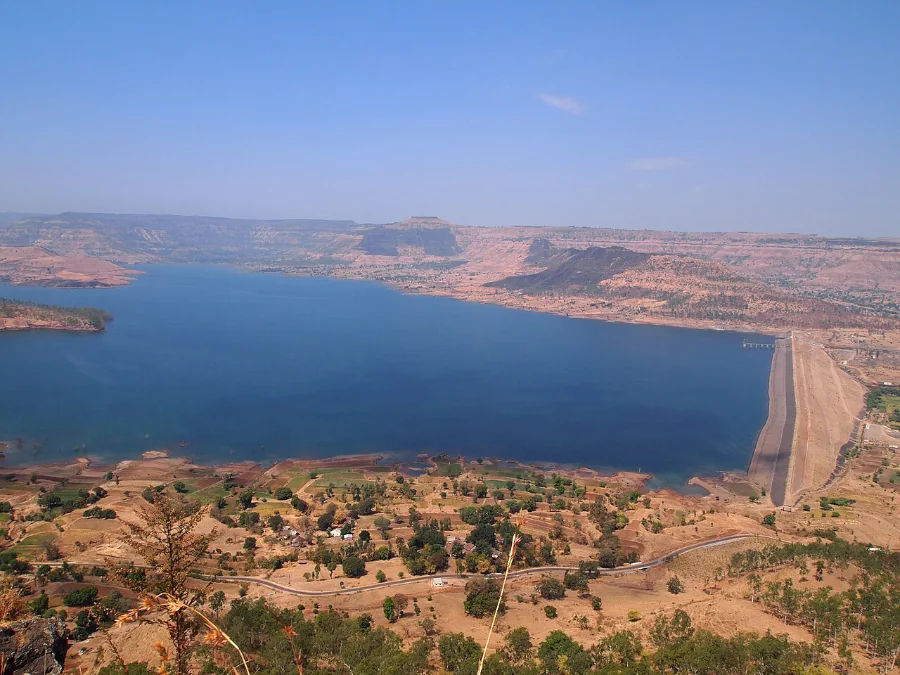
✅︎ Why This Article is Your Ultimate Sajjangad Guide:
➸ Granular History: Uncover the fort’s 700-year timeline—from Bahamani origins to British annexation—with insights from local historians and temple trustees.
➸ Architectural Deep Dive: Explore hidden Gupti (Concealed Swords) in Ramdas Swami’s artefacts, ancient water systems, and tactical gateways.
➸ Beyond the Obvious: Discover monsoon trekking secrets, lesser-known shrines, and hyperlocal festivals.
➸ Practical Intelligence: Precise transport routes, accommodation hacks (like free Dharamshala stays), and seasonal climate nuances.
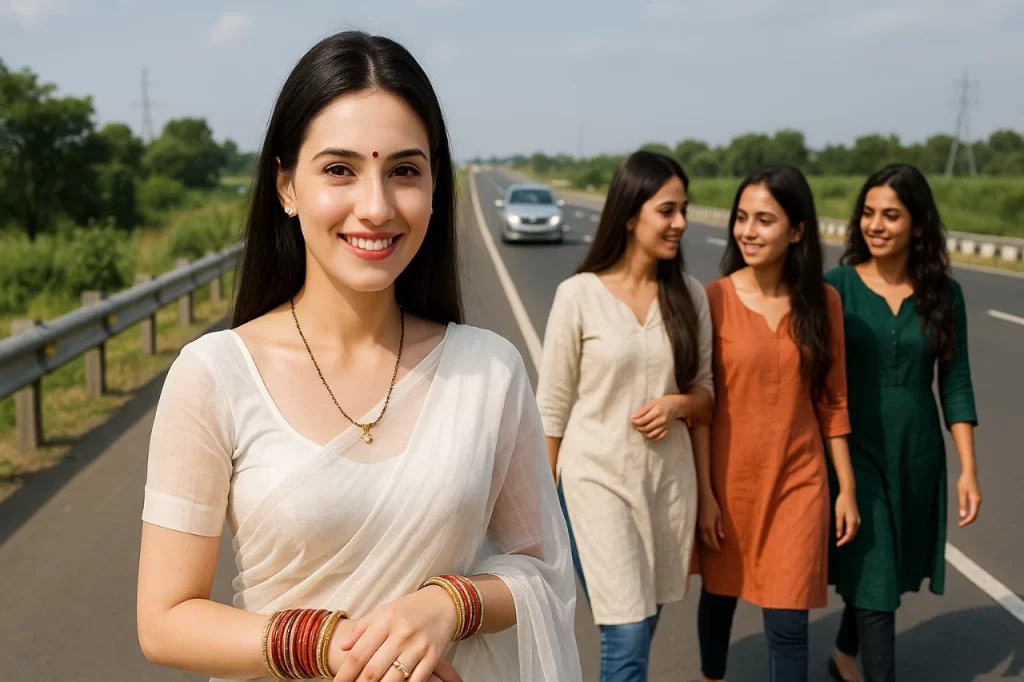
🌄 Comprehensive Introduction to Sajjangad Fort
Perched at 3,350 feet in the Sahyadri range, Sajjangad Fort (17°38′58.9″N 73°54′43″E) is a fusion of Spiritual Sanctity and Maratha Military Legacy. Originally named Parali, it was rebranded “Fort of Good People” (Sajjangad) by Chhatrapati Shivaji Maharaj after gifting it to his Guru, Samarth Ramdas Swami, in 1676. This site evolved from a Bahamani stronghold (1347–1527) to an Adilshahi bastion (1527–1673), before Chhatrapati Shivaji’s conquest on April 2, 1673. Today, it houses Ramdas Swami’s Samadhi (1682) and operates as a living pilgrimage centre under the Shri Ramdas Swami Sansthan Trust, which has preserved rituals for 400 years.
The fort’s Dual Identity — as a strategic fortress and spiritual hub—is etched into its Architecture. Shivaji Mahadarwaja, the main gate, opens to a 230-step climb leading to Ramdas Swami’s Samadhi temple, where Panchdhatu Idols (Gold, Silver, Copper, Brass, Iron) of Ram-Sita-Laxman reside. Key structures include:
➸ Ghodale Lake: A stepped reservoir for cavalry horses.
➸ Ramghal Cave: Ramdas Swami’s meditation spot overlooking the Urmodi Dam.
➸ Shejghar: Ramdas Swami’s preserved room featuring artefacts like Valkala shawls (from Lord Hanuman) and a sword-concealing crutch gifted by Chhatrapati Shivaji Maharaj.
Daily life here pulses with devotion: Kakad Aarti at 5 AM, Dasbodh scripture readings, and free Mahaprasad (lunch/dinner) for pilgrims. During Shiv Jayanti, thousands trek barefoot from Satara, transforming the fort into a canvas of saffron flags and Bhajan processions.
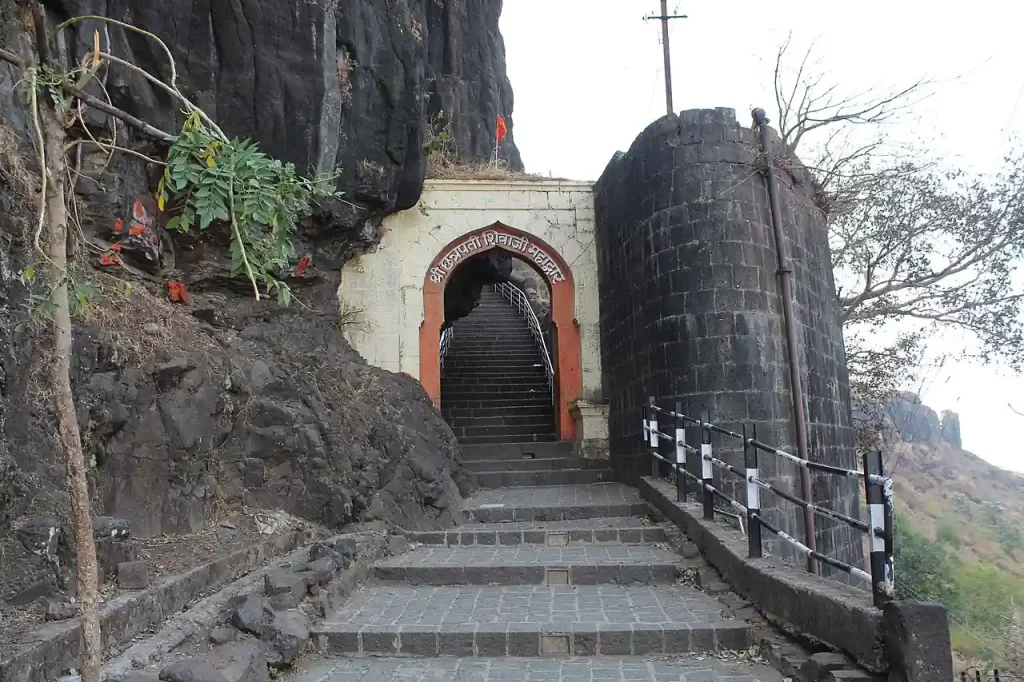
Exploring Sajjangad Fort: History, Spirituality, and Nature
🔴 Detailed Introduction:
⭕ The Soul of Sajjangad: An Expansive Introduction
Nestled in the Sahyadri Mountain Range, Sajjangad Fort (coordinates: 17°38′58.9″N 73°54′43″E) transcends typical historical sites. Its very name, gifted by Shivaji Maharaj, reflects its transformation into a sanctuary for the virtuous. For devotees, it’s Dham (Sacred Ground) — the Samadhi of Samarth Ramdas Swami attracts thousands seeking blessings. For adventurers, its Moderate Trek (230+ steps) rewards with mist-kissed vistas. For culture seekers, daily rituals like Abhishek and Dasbodh recitals echo centuries-old traditions.
The Land and Its Pulse
➸ Climate: Satara district experiences a tropical wet-and-dry climate (Köppen: Aw). Winters (October-February) hover at 10°C – 25°C — Ideal for exploration. Monsoons (June-September) drench the fort in 900–1,500 mm rainfall, painting the Kaas Plateau into a UNESCO-listed “Valley of Flowers”. Summers (March-May) peak at 42°C, best for sunrise views.
➸ Demographics & Culture: The fort’s village, Parali, Embodies Maharashtrian agrarian life. Marathi is the lingua franca, with Hindi/English understood in tourist zones. Local economies thrive on pilgrimage tourism, dairy farming, and Pithla-Bhakri (Chickpea Stew with Millet Bread) stalls lining Satara’s roads.
Also Read
Exploring Badnera, Amravati District, Maharashtra: A Vidarbha Gem of Eastern Maharashtra
⭕ Stones That Speak: A Granular History
From Strategic Citadel to Spiritual Epicenter
➸ 1347–1527: Built by Bahamani rulers as “Asvalgad” (Bear Fort) due to its wild inhabitants.
➸ 1527–1673: Controlled by Adilshahi Dynasty until Chhatrapati Shivaji’s tactical capture on April 2, 1673. He renamed it Sajjangad and invited Ramdas Swami to reside here.
➸ 1681–1700: After Ramdas Swami’s Samadhi (1682), Mughals seized the fort (1700), renaming it “Navrous Tara”. Marathas reclaimed it within years.
➸ 1707–1818: Served as a Maratha administrative hub until British annexation post the Third Anglo-Maratha War.
👉 Local Insight: “Chhatrapati Shivaji Maharaj didn’t just gift a fort; he gifted a sanctuary. Ramdas Swami’s crutch here conceals a sword—symbolising Shakti (Power) and Bhakti (Devotion) intertwined”, shares Trustee Amit Kukarni.
Samarth Ramdas Swami: The Spiritual Architect
Ramdas Swami transformed Sajjangad into a beacon of Dharma. His 11 Maruti Temples dot the Trek Path, and his Dasbodh manuscripts remain recited daily. The fort’s Ramdas Swami Sansthan Trust, operational for 400+ years, preserves his Shejghar (Resting room) with original artefacts:
⦿ A bed gifted by Chhatrapati Shivaji Maharaj
⦿ Valkala shawls (tree bark) from Lord Hanuman
⦿ Copper pots used to fetch water from the Urmodi River.

⭕ Engineering Divinity: Architecture Unpacked
Sajjangad masterfully blends Military Pragmatism with Spiritual Aesthetics
Key Structures:
➤ Fortifications & Gates:
➸ Chhatrapati Shivaji Maharaj Mahadvaar: Main entrance with reinforced bastions.
➸ Ganesh Darwaza: Secondary gate adorned with deity carvings.
➤ Water Management:
➸ Ghodale Lake: Horse watering tank with a stepped design.
➸ Sonale Talav: Rain-fed reservoir still used today.
➤ Sacred Spaces:
➸ Ramdas Swami Samadhi Temple: Houses Panchdhatu (5-metal) idols of Ram-Sita-Laxman.
➸ Ramghal: Ramdas Swami’s meditation cave overlooking valleys.
➸ Dhaabyacha Maruti: Hanuman temple with panoramic viewpoints.
👉 Did You Know? The fort’s walls use interlocked stone masonry without mortar — a technique dissipating seismic energy, crucial in earthquake-prone Satara.
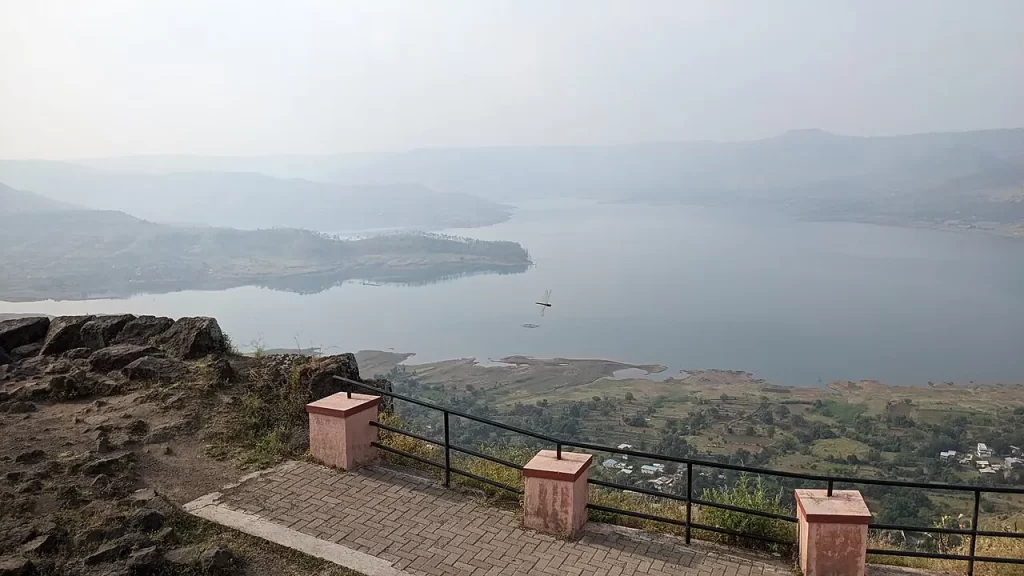
⭕ Journeying to the Fort: Logistics Decoded
Table: Distance & Travel Modes from Key Cities
| City | Distance | By Road (Time) | By Rail | Nearest Airport |
| Pune | 127 km | 3 hrs | Satara Station | Pune International |
| Kolhapur | 138 km | 2.5 hrs | Satara/Miraj | Kolhapur Airport |
| Mumbai | 273 km | 5–6 hrs via NH48 | Satara (Direct buses) | Pune (120 km) |
| Bengaluru | 850 km | 14 hrs | Satara (Connecting) | Pune International |
Note: Distance is approximate and travel time may vary. Please check with google maps or local authorities before travelling.
👉 Pro Tips:
➸ Last-Mile Access: From Satara, take an Auto-rickshaw (₹150 – ₹200) or Bus from Rajwada Stand to the base. Drive 8 km uphill, then climb 230 steps.
➸ Accessibility: Elderly pilgrims use Palkhis (Palanquins; ₹500 – ₹800).
➸ Monsoon Advisory: Roads get slick; hire 4WDs. Avoid trekking during heavy downpours.
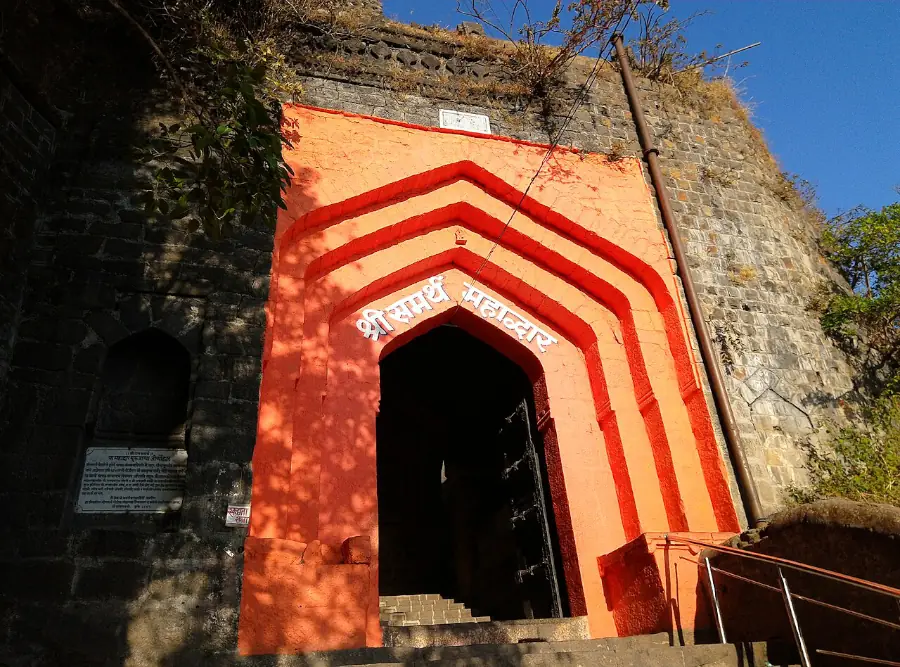
⭕ Immersive Experiences: Beyond the Ordinary
➤ Rituals & Festivals
➸ Daily: Kakad Aarti (5 AM), Maha Naivedya (noon feast), Dhoop Aarti (7 PM). Free Prasad lunch/dinner served.
➸ Shiv Jayanti: Thousands walk barefoot from Satara. Expect Palkhi processions and Bhajan Marathons.
➤ Nature & Photography
➸ Sunrise at Ramghal: Mist-layered valleys in golden hues.
➸ Birding: Spot Brahminy kites, Indian bee-eaters, and parrots.
➸ Monsoon Magic: Capture the fort emerging from clouds, with Thoseghar Falls thundering nearby.
➤ Unexplored Corners
➸ Sridhar Kuti: Hermitage for Ramdas Swami’s ascetic disciples.
➸ Bramhapisa Temple: Ancient shrine for tantric rituals.

⭕ Beyond the Ramparts: Nearby Treasures
Table: Must-Visit Attractions within 40 km
| Attraction | Distance | Highlight | Best Time |
| Ajinkyatara Fort | 18 km | Chhatrapati Shivaji’s Observatory; Cable Car Access | October–March |
| Kaas Plateau | 25 km | 850+ flower species; UNESCO site | August–September (Monsoon) |
| Thoseghar Falls | 26 km | 500-ft Cascade; Viewpoint Galleries | July–October |
| Chalkewadi Windmills | 32 km | Asia’s 2nd largest Wind Farm; Sunset Vistas | Year-round |
👉 Photographer Ashutosh Mankhair’s Tip: “At Kaas, arrive by 6:30 AM to photograph Utricularia blooms before crowds. Near Sajjangad, the Urmodi Dam’s backwaters mirror the fort at dawn”.
⭕ Travel Toolkit: Weather, Stay & Food
➤ Climate-Proof Your Visit
☁️ October–February (Winter): Pleasant (10°C – 25°C). Pack layers. Ideal for trekking.
🌧️ June–September (Monsoon): Lush but slippery. Wear grip shoes. Risk: Leeches.
☀️ March–May (Summer): Hot days (up to 42°C), cool nights. Start treks by 6 AM.
➤ Stay & Savours
⦿ Free Accommodation: Shri Ramdas Bhaktiniwas (Dormitory). Register by 5 PM.
⦿ Satara Hotels: Krishna Continental (Luxury) or Yatri Niwas (Budget).
⦿ Local Eats: Try Satara Miryachi Bhakri (Spiced Millet Bread), Pithla and Puran Poli at base stalls.
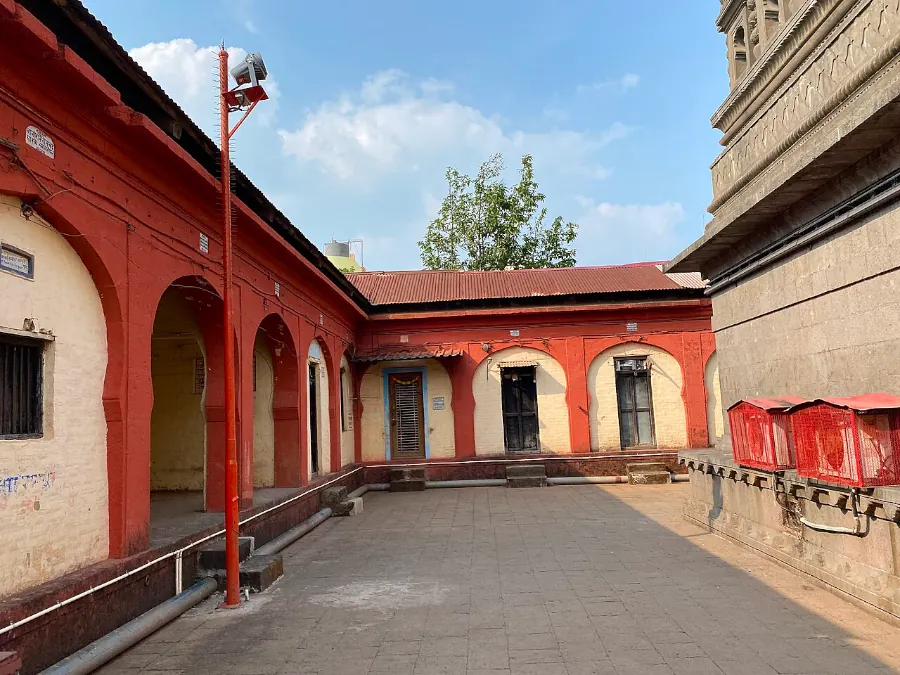
⭕ Voices from the Fort: Cultural Mosaic
👉 Pilgrim Profile: “We newlyweds come to Ramdas Swami’s samadhi for Ashirwad. It’s believed couples bonding here receive lifelong harmony”, – Priya Deshpande, Pune.
👉 Trustee Ritual: “Every dawn, we bathe Ramdas’s Paduka (Sandals) with milk. His presence is palpable”, – Trustee, Sansthan.
🟢 Detailed Sectional Breakdown:
🏰 Architectural Marvels of Sajjangad Fort: A Granular Exploration
🔘 Fortifications & Gates: Military Ingenuity
➸ Shivaji Maharaj Mahadwara (Main Gate): Constructed with 10-foot-thick stone walls and reinforced bastions, this entrance features iron-spiked doors and carvings of Chhatrapati Shivaji’s coronation symbols (lotus and sword), symbolising Bhakti-Shakti (Devotion-power duality) . Arrow slits flank the gateway, designed for archers to repel invaders.
➸ Ganesh Darwaza (Inner Gate): Adorned with deity carvings and a Nandi (Bull) sculpture facing Ramdas Swami’s Samadhi, aligning with Shaivite traditions. Its Elevated Position provided tactical oversight of approaching forces.
🔘 Water Management Systems: Engineering Mastery
➸ Ghodale Lake: A stepped reservoir engineered for cavalry horses, using a Reverse Siphon System to channel rainwater from higher cliffs. Stone channels ensured year-round supply, critical during sieges.
➸ Sonale Talav: A rain-fed lake with Ghats (Steps) for ritual bathing. Inscriptions confirm its construction under Chhatrapati Shivaji’s supervision (1675 CE). The tank’s 2-meter depth prevented evaporation in summer.
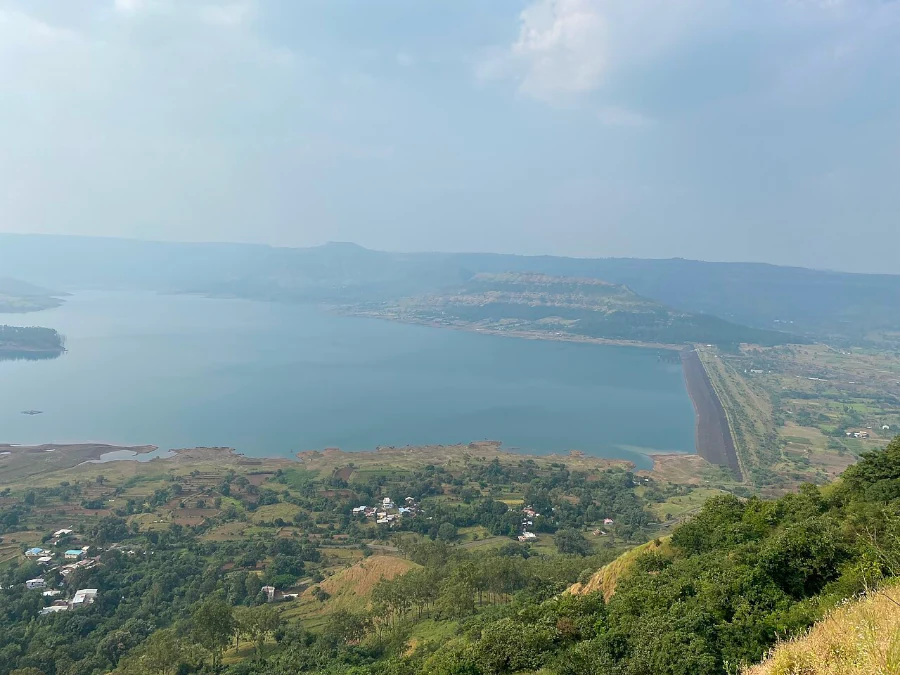
🔘 Sacred Architecture: Spiritual Nexus
➨ Samadhi Temple of Samarth Ramdas Swami: Houses Panchdhatu Idols (Gold, Silver, Copper, Brass, Iron) of Ram-Sita-Laxman. The sanctum preserves Ramdas Swami’s original artefacts:
➸ A sword-concealing crutch gifted by Chhatrapati Shivaji (Symbolising Spiritual Power Amid Humility).
➸ Valkala shawls woven from tree bark, believed bestowed by Lord Hanuman.
➨ Ramghal Cave: Ramdas Swami’s meditation site, carved into the western cliff. Its 180-degree vista of the Urmodi Dam was strategically positioned for solitude and surveillance.
🔘 Defensive Infrastructure: Tactical Innovations
➸ Watchtowers & Bastions: Eight bastions equipped with Cannon Mounts facing former Mughal invasion routes. The northwestern tower (“Dhaabyacha Maruti”) doubled as a Hanuman temple, where devotees tie Mani (Pledge Threads) to the deity’s mace.
➸ Rampart Walls: 3.5 km of interlocked Stone Masonry (No Mortar), dissipating seismic energy — a necessity in earthquake-prone Satara. Walls taper from 12 ft (base) to 8 ft (summit) for stability.
🔘 Residential & Administrative Structures
➸ Shejghar (Ramdas Swami’s Quarters): Features a stone bed gifted by Shivaji, copper water vessels, and manuscripts of Dasbodh. The room’s East-facing orientation maximised morning light for scripture study.
➸ Trustee Math (Sansthan Office): A 17th-century administrative hub with original ledgers detailing fort provisions. The vaulted ceiling uses Deccan trap basalt, providing natural cooling.
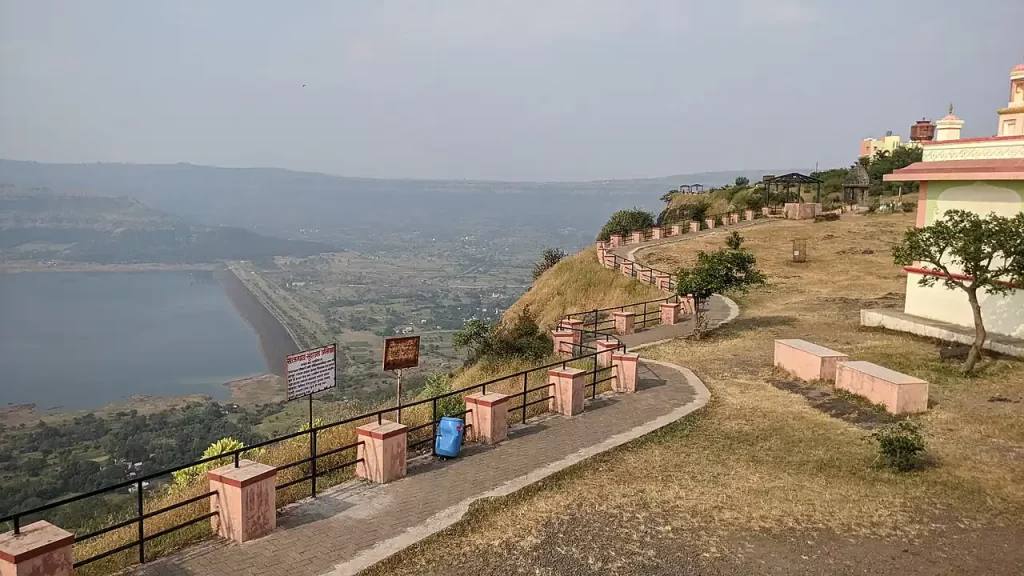
🔘 Hybrid Religious Spaces: Syncretism in Stone
➸ Mughal-Era Mosque: Built during brief Mughal occupation (1700–1707), featuring a Mihrab (Prayer Niche) oriented toward Mecca. Persian-Marathi inscriptions on adjacent slabs reveal cultural blending.
➸ Anglai Devi Shrine: A pre-Maratha folk deity shrine assimilated into the fort complex. The idol’s Tribal Iconography (Serpent Headdress, Trident) reflects local traditions.
🔘 Hidden & Ceremonial Sites
➸ Bramhapisa Shrine: Used for tantric rituals, with a Yagna Kund (Fire Pit) and carvings of Dakinis (Female Spirits). Local lore claims Ramdas Swami performed eclipse rites here.
➸ Sridhar Kuti Hermitage: A secluded cell for ascetic disciples, storing rare manuscripts like ‘Manache Shlok’. An attached Tulsi garden provided herbs for rituals.
🔘 Construction Techniques & Materials
➸ Stone Sourcing: Basalt quarried from the Sahyadris, transported via inclined ramps using bullock pulleys. Chisel marks on blocks show Adilshahi-era floral motifs repurposed by Marathas.
➸ Climate Adaptations: Ventilation shafts in living quarters channeled hill breezes, while lime-jaggery mortar in joints expanded during monsoons to prevent leaks.

⚖️ Architectural Legacy: Military Pragmatism Meets Spiritual Serenity
Sajjangad’s genius lies in its Dual-purpose design:
➸ Strategic Elements: Parapets wide enough for cavalry (15 ft), camouflaged escape tunnels to Urmodi Valley.
➸ Sacred Symbolism: Temple Kalashas (Spires) aligned with solstice sunrises, bathing Ramdas Swami’s Samadhi in light on his Birth Anniversary.
This synthesis of Bahamani Robustness, Adilshahi Ornamentation and Maratha Spirituality makes Sajjangad an unparalleled testament to Maharashtra’s Architectural heritage — where every stone whispers Dharma (Duty) and Disha (Direction).
🏨 Where to Stay in and near Sajjangad Fort: Granular Accommodation Guide
⛔ On-Fort Spiritual Stays: Shri Ramdas Bhaktiniwas (Dharamshala)
➸ Location: Inside Sajjangad Fort, adjacent to Samadhi Temple.
➸ Rates: Free (donations appreciated).
➸ Check-in: Register by 5 PM daily; no advance bookings. Identity proof (Aadhar/PAN/passport) mandatory.
➸ Facilities:
⦿ Basic dormitory-style rooms with Indian/Western toilets.
⦿ Hot water, ceiling fans, mattresses, and cots provided.
⦿ Free Satvik Meals: Tea (6 AM), Breakfast (9:30 AM), Lunch/Dinner (Prasad).
➸ Ideal For: Pilgrims seeking immersion in daily rituals (Kakad Aarti, Dasbodh recitals).
➸ Limitations: No AC, Wi-Fi, or private rooms; 24-hour silence norms enforced.
⛔ Budget Options (Under ₹1,500/Night)
➸ Sai Samrat Resort (12.82 km from fort):
⦿ Rate: ₹1,610/night.
⦿ Facilities: AC rooms, cable TV, attached bathrooms, banquet hall.
⦿ Food: On-site restaurant serving Maharashtrian thalis.
⦿ Check-in: 12 PM.
➸ Vayu Homestay (7.92 km from fort):
⦿ Rate: ₹800 – ₹3,625/night (seasonal).
⦿ Facilities: Shared kitchen, BBQ space, garden views, halal food options.
⦿ Food: Free breakfast; café serving local snacks (Poha, Vada Pav).
⛔ Mid-Range Hotels (₹1,500 – ₹3,000/Night)
➸ Treebo City Inn Satara (10.43 km from fort):
⦿ Rate: ₹2,337/night.
⦿ Facilities: AC rooms, LED TV, free Wi-Fi, 24-hour front desk.
⦿ Food: Room service; proximity to Satara’s Miryachi Bhakri stalls.
➸ Maratha Palace (11.35 km from fort):
⦿ Rate: ₹2,206/night.
⦿ Facilities: Hill-view Rooms, Multi-cuisine Restaurant (Maharashtrian/Punjabi/South Indian).
⦿ Check-in: 2 PM; ideal for business travellers with conference facilities.

⛔ Luxury & Resorts (₹3,000+/Night)
➸ The Fern Residency (12.03 km from fort):
⦿ Rate: ₹3,696/night.
⦿ Facilities: Pool, fitness centre, restaurant (FLAVORS), 24-hour room service.
⦿ Food: Continental breakfast (₹350 extra); fine-dining options.
➸ Nivant Hill Resort (5.98 km from fort):
⦿ Rate: ₹2,277/night.
⦿ Facilities: Spa, landscaped gardens, cable TV, laundry.
⦿ Check-in: 12 PM; complimentary parking and breakfast.
⛔ Farm-stays & Nature Retreats
➸ Ingawale Farmhouse (11.07 km from fort):
⦿ Rate: ₹1500/night.
⦿ Facilities: Seasonal pool, fireplace, kitchen, capacity for 32 guests.
⦿ Food: Cooked-to-order breakfast (extra fee); BBQ facilities.
➸ Swapnnagari Kas Hill Resort (25 km near Kaas Plateau):
⦿ Rate: ₹2,500 – ₹4,000/night for cottages.
⦿ Facilities: Sunset viewpoints, cricket ground, garden-facing AC cottages.
⦿ Food: Restaurant serving Malvani seafood and Thalipeeth.
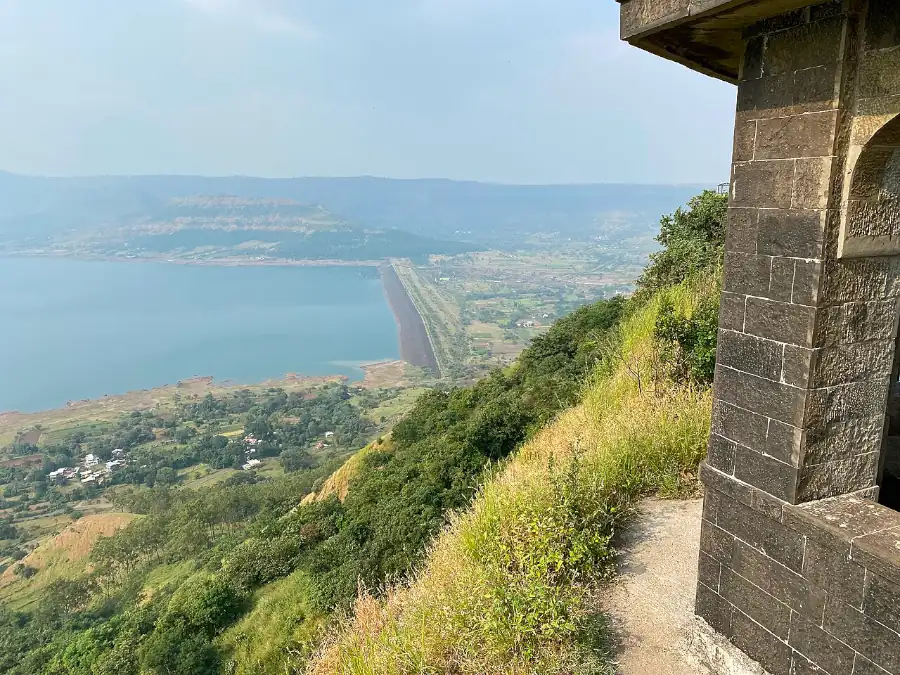
⛔ Pilgrim-Focused Lodges
➸ Shri Samarth Lodge (Fort base):
⦿ Rate: Free/donation-based (managed by Sansthan Trust).
⦿ Facilities: Shared bathrooms, drinking water, proximity to step ascent.
⦿ Food: Free Mahaprasad during temple hours.
Note: Hotel rates are subject to change and may vary based on factors like seasonality, availability, and promotions. Taxes, service charges, and other applicable fees are not always included in displayed rates.
🗺️ Strategic Location Insights
➸ Proximity to Fort: Nivant Hill (5.98 km) > Vayu Homestay (7.92 km) > Sai Samrat (12.82 km).
➸ Near Attractions:
⦿ Kaas Plateau: Swapnnagari Resort (5 km).
⦿ Thoseghar Falls: Ingawale Farmhouse (26 km).
⚠️ Critical Considerations
1. Monsoon Access (June–September): Roads to fort become slippery; 4WD vehicles recommended.
2. Dharamshala Rules: Strict 9 PM curfew; no alcohol/non-vegetarian food.
3. Festival Bookings: Shiv Jayanti (March) requires 3-month advance reservations for Fern/Nivant.
💎 Hidden Gems
➸ Fulora Hotel (12.29 km): Terraced rooms with Krishna River views (₹2,718/night).
➸ Elite Boutique Hotel (Satara city): Heritage rooms with Jacuzzi (₹4,200/night).
🛎️ Booking Tips
➸ Off-Season Discounts: 30% off at Maratha Palace (July–September).
➸ Group Stays: Ingawale Farmhouse charges ₹25/person for >10 guests.
This spectrum of stays—from austere spiritual lodgings to luxury resorts—ensures every traveler finds solace near Sajjangad’s hallowed ramparts. 🕉️

🌄 Best Places to Visit in Sajjangad Fort: A Granular Exploration
⭕ Samarth Ramdas Samadhi Temple: The Spiritual Epicenter
The Samadhi (Final Resting Place) of Samarth Ramdas Swami stands as the fort’s spiritual nucleus. Encased within a marble structure adorned with Panchdhatu (Five Metals: Gold, Silver, Copper, Brass, Iron) idols of Ram-Sita-Laxman, this sanctum draws thousands of devotees daily. The temple complex includes:
➸ Shejghar: Ramdas Swami’s preserved living quarters displaying original artefacts—a crutch concealing a sword (gifted by Shivaji), Valkala shawls (tree bark from Lord Hanuman), and copper water vessels.
➸ Daily Rituals: Kakad Aarti at 5 AM, Maha Naivedya (Offering) at noon, and Dasbodh scripture recitals. Free Prasad (lunch/dinner) served in communal halls fosters unity among pilgrims.
➸ Shiv Jayanti Celebrations: Over 10,000 devotees gather annually for processions, Bhajan marathons, and night-long vigils.
⭕ Ramghal Meditation Cave: Where Serenity Meets Vistas
Perched on the fort’s western edge, Ramghal is the cave where Ramdas meditated. This spot offers uninterrupted 180-degree views of the Urmodi Dam’s backwaters and the Sahyadri ranges. At sunrise, mist blankets the valleys, creating an ethereal atmosphere ideal for meditation. Stone benches carved into the cliff allow quiet contemplation, while monsoon transforms the area into a waterfall-draped sanctuary.
Also Read
Sendhwa, Madhya Pradesh – A Hidden Gem of History, Culture, and Natural Beauty
⭕ Ghodale Lake & Sonale Talav: Engineering Marvels
➸ Ghodale Lake: A stepped reservoir designed for cavalry horses during Maratha rule. Its unique “Reverse Siphon” System channeled rainwater from higher cliffs, ensuring year-round supply. Today, lotus blooms adorn its surface, attracting kingfishers and herons.
➸ Sonale Talav: Located near the Sansthan office, this rain-fed lake features a stone Ghat (Steps) for ritual bathing. Inscriptions confirm its construction under Chhatrapati Shivaji’s supervision (1675).
⭕ Dhaabyacha Maruti Temple: Sentinel of the Ramparts
This 17th-century Hanuman temple, named “Guardian Maruti”, served as a strategic watchtower. Its elevated platform reveals:
➸ Fortification Views: Crumbling bastions and cannon mounts facing former Mughal invasion routes.
➸ Panoramic Vantage: Overlooks the 230-step ascent path and the Chalkewadi windmill farms (32 km away).
Devotees tie Mani (Pledge Threads) to the deity’s mace, seeking protection — a tradition dating to Ramdas Swami’s era.
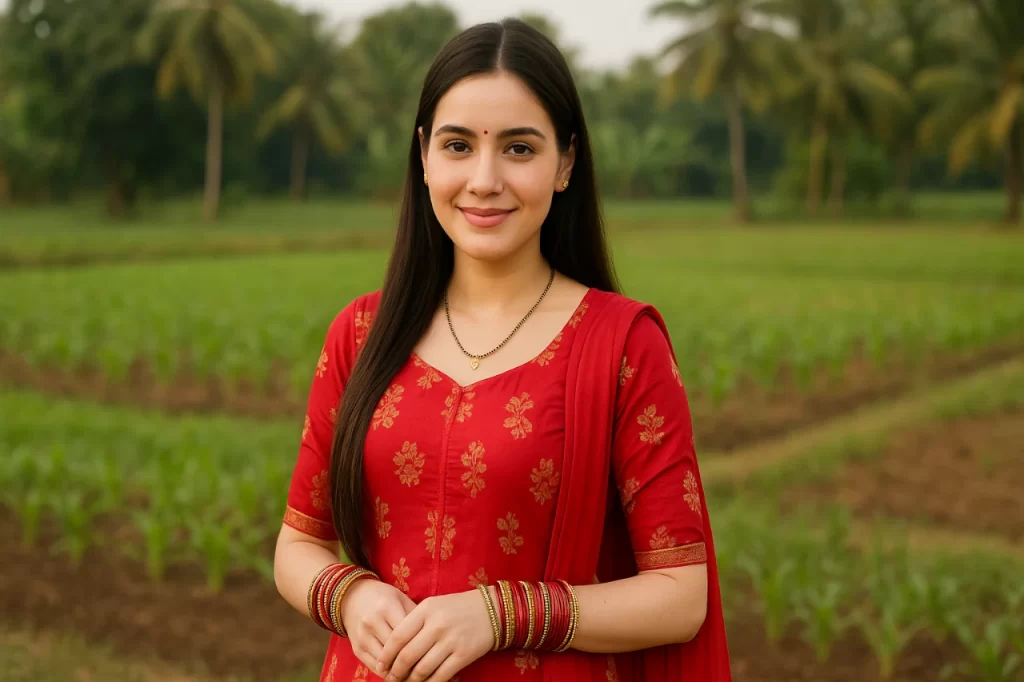
⭕ The Twin Gates: Portals to History
➸ Chhatrapati Shivaji Maharaj Mahadvaar: The main entrance features 10-foot-thick walls and iron-spiked doors. Carvings depict Chhatrapati Shivaji’s coronation symbols—a lotus and sword—symbolising Bhakti-Shakti (devotion-power).
➸ Shree Samarth Mahadvaar: The inner gate houses a Nandi (Bull) sculpture facing Ramdas Swami’s Samadhi, aligning with Shaivite traditions. Arrow slits in its walls highlight defensive ingenuity.
⭕ Sridhar Kuti & Bramhapisa Shrine: Hidden Sanctuaries
➸ Sridhar Kuti: A hermitage for Ramdas Swami’s ascetic disciples, now housing rare manuscripts like Manache Shlok (verses on mind control). The attached garden grows Tulsi (Holy Basil) used in rituals.
➸ Bramhapisa Temple: An ancient shrine for tantric rituals, with a Yagna Kund (Fire Pit) and carvings of Dakinis (Female Spirits). Local lore claims Ramdas Swami performed lunar eclipses rites here.
⭕ Mughal-Era Mosque & Temple Remnants: Layers of Legacy
A dilapidated structure near Ghodale Lake, built during Mughal occupation (1700–1707), features a Mihrab (Prayer Niche) facing Mecca. Adjacent stands a shrine to Anglai Devi — a local folk deity assimilated by Marathas. Stone fragments with Persian-Marathi inscriptions reveal cultural syncretism.
⭕ The Northern Rampart Walk: Nature’s Theatre
A 1.2-km trail along the fort’s perimeter offers:
➸ Urmodi Dam Vistas: Sunset reflections turn the Reservoir Golden (best viewed October–February).
➸ Biodiversity: Monitor lizards basking on rocks, Pandhari Orchids (June–September) and migratory Shaheen Falcons (November–March).
Benches inscribed with verses from Dasbodh punctuate the Path, Blending Philosophy with Scenery.
⚠️ Visiting Insights: Timing, Access & Etiquette
➸ Ideal Hours: 6:00–9:00 AM for Rituals; 4:00–6:00 PM for Sunset views.
➸ Climb Notes: 230 steps take ~25 minutes; palanquins available (₹500 – ₹800 for elderly).
➸ Rules: No photography in sanctums; dress modestly (covered shoulders/knees); silence zones near Samadhi.
Sajjangad transcends typical fort visits — it’s where History breathes through Stones, Spirituality Echoes in Chants and Nature Paints Masterpieces. Each corner invites discovery, from whispered legends in Ramghal’s cave to resilience etched into its ramparts 🕉️.

🌄 Comprehensive Guide: How to Reach Sajjangad Fort from Across India
✈️ Gateway Airports: Pune and Mumbai
➨ Pune International Airport (120–130 km):
➸ Connectivity: Direct flights from Delhi, Bengaluru, Hyderabad, and International hubs like Dubai.
➸ Onward Travel: Prepaid taxis (₹2,500 – ₹3,000) or state buses (₹200 – ₹400) to Satara (3–4 hours).
➨ Mumbai Chhatrapati Shivaji Maharaj Airport (273 km):
➸ Connectivity: Global flights from Europe, Americas, and Asia.
➸ Onward Travel: Ola/Uber (₹7,000–₹8,000) or Vijayanand Travels buses (₹645 – ₹840, 4.5–5 hours) to Satara via NH48.
🚂 Rail Routes to Satara Junction
➸ From Mumbai: Dadar–Satara Express (6h17m; ₹220 – ₹760 AC).
➸ From Pune: Frequent local trains (3h; ₹50–₹150 unreserved).
➸ From Bengaluru/Delhi: Disembark at Miraj Junction (138 km away), then Taxi/Bus to Satara (2.5 hours).

🛣️ National Highways: Driving Directions
➨ NH48 (Mumbai → Sajjangad, 273 km):
➸ Route: Mumbai → Panvel → Pune → Khambatki Ghat → Satara → Fort (5–6 hours).
➸ Toll Cost: ₹550–₹650.
➨ Bengaluru→Sajjangad (850 km):
➸ Route: Bengaluru → Kolhapur → Karad → Satara (14 hours).
➸ Recommended Stops: Kolhapur for Tambda Rassa (Spicy Mutton Curry).
🚌 State Transport Buses
➸ Mumbai → Satara: MSRTC Volvo buses (₹600–₹800; 5 hours) from Dadar or Borivali.
➸ Pune → Satara: Shivshahi buses every 30 mins (₹180 – ₹250; 3 hours).
➸ Ahmedabad/Nagpur: Overnight sleeper buses (₹800 – ₹1,200; 12–14 hours).
🚗 Private Vehicle Tips
➸ Parking: Designated area at fort base (₹50/day).
➸ Monsoon Advisory: Avoid Khambatki Ghat (landslide-prone); use 4WD vehicles.
➸ EV Charging: Stations at Satara city (18 km before fort).

🛺 Last-Mile Access from Satara
➸ Autorickshaw: From Satara bus stand (₹150 – ₹200; 30 mins).
➸ Local Buses: MSRTC buses from Rajwada Stand (₹20/person; hourly) .
➸ Climb: 230 stone steps from parking to fort entrance. Palkhis (Palanquins) available for elderly (₹500 – ₹800).
🏁 Regional Connectivity from Key Cities
➨ Hyderabad → Satara (560 km):
➸ Drive: NH65 via Solapur (9 hours).
➸ Bus: Sri Srinivasa Travels (₹900 – ₹1,400; 10 hours).
➨ Goa → Satara (330 km):
➸ Konkan Railway to Miraj, then taxi (6 hours).
🔍 Traveler Insights & Pro Tips
➸ Crowd Management: Avoid Shiv Jayanti (March) and weekends; fort closes at 9 PM.
➸ Budget Hack: Free accommodation at Shri Ramdas Swami Bhaktiniwas (register by 5 PM).
➸ Local Apps: Use “Maharashtra Tourism” for real-time bus/train updates.

🚆 Distance & Time Summary Table
| Origin City | Distance (km) | By Air + Road | By Train | By Road |
| Pune | 127 km | N/A | 3 hrs | 3 hrs |
| Mumbai | 273 km | 1h flight + 3h drive | 6 hrs 17 min | 5–6 hrs |
| Bengaluru | 850 km | 1.5h flight + 3h drive | 16 hrs (Miraj) | 14 hrs |
| Delhi | 1,450 km | 2h flight + 3h drive | 20 hrs (Miraj) | 24 hrs |
Note: Distance is approximate and travel time may vary. Please check with google maps or local authorities before travelling.
🌤️ Monsoon-Specific Itineraries
➸ Day 1: Mumbai → Satara (NH48; 5h) → Overnight at Nivant Hill Resort (5.98 km from fort).
➸ Day 2: Satara → Sajjangad (8 AM climb; Mist-free Views) → Thoseghar Falls (26 km) → Return by 7 PM.
⚠️ Critical Considerations
➸ Medical Access: Nearest hospital in Satara (18 km); carry motion-sickness meds for ghat roads.
➸ Border Permits: International tourists require inner-line permits for photography near windmill farms.
This exhaustive guide ensures seamless access to Sajjangad—whether you seek spiritual solace, historical immersion, or Sahyadri vistas. 🚗💨

🍽️ Best Places for Refreshments with Authentic Local Food: A Granular Culinary Journey
Sajjangad Fort and its surrounding Satara region offer a rich tapestry of Maharashtrian flavours, blending spiritual simplicity with robust regional cuisine. From Satvik Temple meals to fiery Kolhapuri dishes, here’s an exhaustive guide to savouring authentic local food:
🔘 Sajjangad Fort Prasadalaya: Spiritual Sustenance
➸ Location: Inside the fort complex, adjacent to Ramdas Swami Samadhi.
➸ Specialties: Free Satvik meals (no onion/garlic) featuring:
⦿ Puran Poli: Sweet lentil-stuffed flatbread with Ghee.
⦿ Bharli Vangi: Eggplants stuffed with coconut-peanut masala.
⦿ Pithla-Bhakri: Chickpea flour curry with millet bread.
➸ Timings: Lunch (12:00–1:00 PM), Dinner (7:30–8:30 PM).
➸ Experience: Communal dining in Bhojanshala (Dining Hall); meals prepared as offerings to Ramdas Swami. Jowar (Sorghum) grains used are locally sourced from Satara farms.
🔘 Hotel Chandravilas Bhuvan, Satara (12 km): Heritage Breakfast
➸ Location: Khalcha Rasta, Malhar Peth, Satara.
➸ Specialties:
⦿ Misal Pav: Spicy Sprouted-lentil Curry topped with Farsan (Crispy Noodles), Onions & Lemon (₹60).
⦿ Puri Bhaji: Fluffy Puris with Potato Curry (₹50).
⦿ Malai Barfi: Milk-based Fudge (₹300/kg).
➸ Ambience: 1947-established eatery with vintage Bollywood décor; open kitchen.
➸ Pro Tip: Arrive by 7:30 AM to avoid queues. Shev (savoury snacks) sold for takeaway.

🔘 Hotel Pranjali, NH4: Highway Haunt for Thalis
➸ Location: Sangamnagar, National Highway 4.
➸ Signature Dishes:
⦿ Mutton Thali: Sajuk Tupatil Mutton (Slow-cooked in Ghee), Tambda Rassa (Red Chili Gravy), Bharleli Vangi and Jowari Roti (₹220).
➸ Veg Thali: Zunka (Gram Flour Curry), Matki Usal and Puran Poli (₹150).
➸ Unique Touch: Served with Shengdana-gul (Peanuts-jaggery mix) as digestive.
🔘 Mapro Garden, Panchgani (34 km): Fruit-Centric Delights
➸ Location: Panchgani – Mahabaleshwar Road.
➸ Must-Try:
⦿ Strawberry Cream: Fresh berries with vanilla ice cream (₹180).
⦿ Mulberry Jam: Artisanal preserves (₹350/jar).
⦿ Thalipeeth: Multigrain Pancakes with Thecha (Chili-garlic Chutney).
➸ Ambience: Orchard-facing seating; factory tours available.
🔘 Rajwada Road Street Stalls: Budget-Friendly Bites
➸ Location: Near Satara Bus Stand.
➸ Top Picks:
⦿ Kanda Bhaji: Onion Fritters (₹20) with Tamatar Chutney.
⦿ Vada Pav: Potato Dumplings in Bun (₹15).
⦿ Sugarcane Juice: Chilled with Ginger-lemon (₹30).
➸ Seasonal Highlight: Monsoon-only Bhutta (Grilled Corn with Chili Powder & Lime).
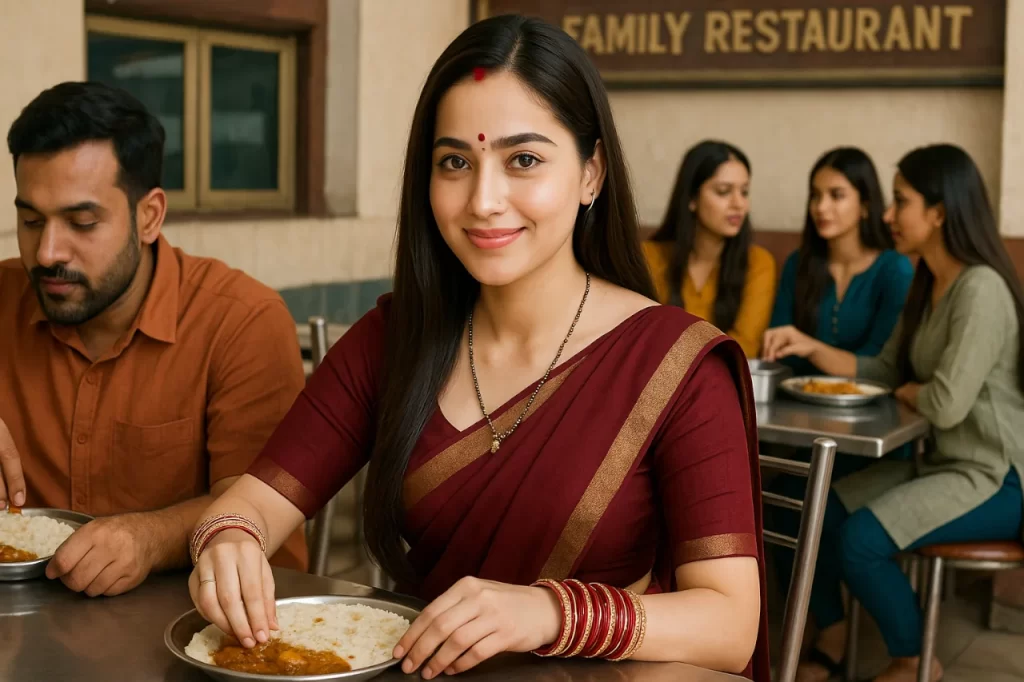
🔘 Ashok Modi Kandi Pedhewale: Sweet Traditions
⦿ Location: Vithal Leela Complex, Powai Naka.
⦿ Famous For: Kandi Pedhe: Milk solids shaped into balls, slow-stirred in copper Kadhai (₹400/kg).
⦿ History: Family recipe since 1950s; uses Satara’s A2 milk.
🔘 Home-stays & Farmsteads: Hyperlocal Experiences
➸ Vayu Homestay (8 km):
⦿ Cooking Workshops: Learn to make Thalipeeth with Farm-fresh Millets (₹500/person).
⦿ Meals: Pithla-rice with Papad; ingredients sourced from on-site gardens.
➸ Ingawale Farmhouse (11 km):
⦿ BBQ Nights: Kolhapuri Bhadang (Spicy Puffed Rice) paired with local Dahané Wine.
🔘 Festive & Seasonal Specials
➸ Shiv Jayanti (March):
⦿ Fort Feast: Free Amrakhand (Mango-yogurt Dessert) distributed after Aarti.
➸ Monsoon (June–September):
⦿ Thoseghar Falls Stalls: Steaming Bhajiyas (Fritters) and Chai enjoyed amid mist.
➸ Winter (October–February):
⦿ Kaas Plateau Vendors: Poha with Ratrani flower honey.
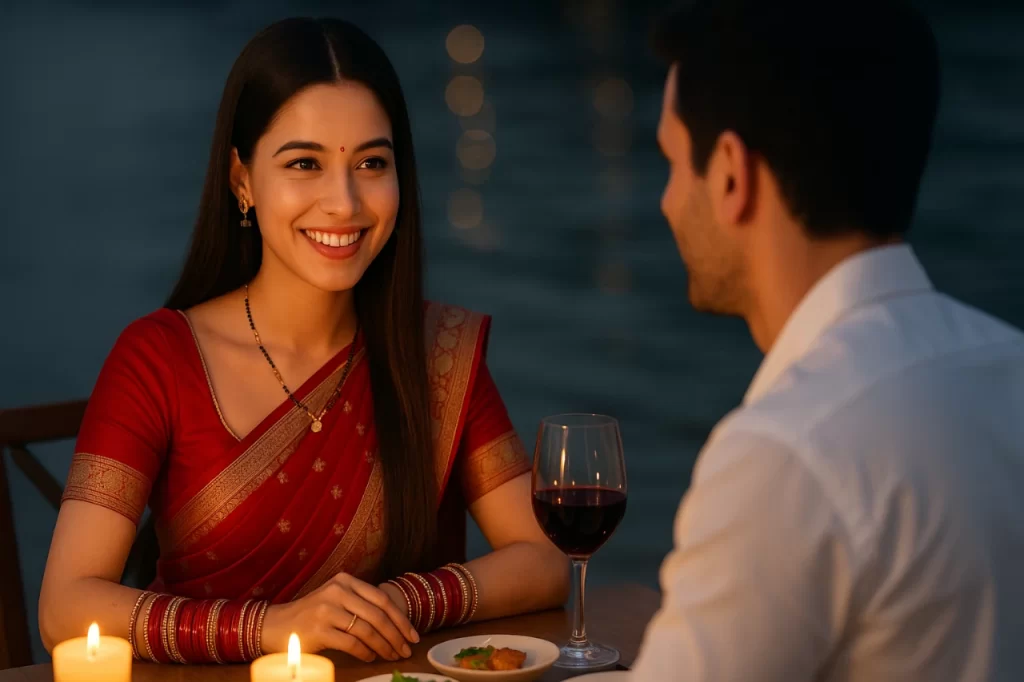
🍃 Cultural Insights & Pro Tips
➸ Ethical Dining: Non-vegetarian food is avoided within 5 km of the fort (considered sacred) .
➸ Cost Guide: Street snacks (₹20 – ₹100), mid-range Thalis (₹150 – ₹250), luxury dining (₹400+/person).
➸ Local Secret: Gulbahar Restaurant (Sadar Bazar) serves rare Satkar – Marinated Mutton (₹280) for non-veg seekers.
From temple Prasad to heritage thalis, Sajjangad’s food landscape mirrors Maharashtra’s soul—simple, spiritual, and explosively flavourful. 🫓 🌶️
👑 Notable People and Their Work
| Person | Contribution |
| Samarth Ramdas Swami | Spiritual Guru; Authored Dasbodh; Established 11 Hanuman Temples. |
| Chhatrapati Shivaji Maharaj | Liberated Sajjangad (1673); Institutionalised Naval Forts. |
| Chhatrapati Sambhaji Maharaj | Sheltered at Sajjangad during Mughal conflicts (1681). |
| Nana Fadnavis | Revitalised Satara’s forts Post-Peshwa era. |
🧑🤝🧑 Demographics of Satara District
⦿ Population: 3.003 million (2011 census).
⦿ Languages: Marathi (85%), Hindi (8%), English (urban areas).
⦿ Economy: Agriculture (soybean, sugarcane), tourism, engineering industries.
☀️ Climatic Conditions
☁️ Winter (October–February): 10°C – 25°C; Ideal for Trekking.
🌧️ Monsoon (June–September): 1,500 mm rainfall; Mist-laden Landscapes.
☀️ Summer (March–May): 28°C – 42°C; Early-morning visits recommended.
🗺️ Complete List of Talukas (Tehsils)
➸ Satara
➸ Karad
➸ Wai
➸ Phaltan
➸ Koregaon
➸ Khatav
➸ Maan
➸ Patan
➸ Jaoli
🏭 Industrial Development & Key Industries
➸ Core Sectors:
⦿ Engineering: Cooper Corp (Diesel Engines; Revenue ₹1,200 crore).
⦿ Pharmaceuticals: Top companies in Satara city.
⦿ Food Processing: Mapro Foods (Fruit Jams; Exports Globally).
➸ Commercial Activities:
⦿ Weekly Bazaars: Agri-produce markets in Wai (Sundays).
⦿ Wind Energy: 300 MW generated at Chalkewadi.
⚙️ Famous Industries & Companies
| Company | Product | Revenue |
| Cooper Corp | Engines, Tractors | $150 M |
| Mapro Foods | Fruit Conserves | $40 M |
| Satara Metal Works | Automotive components | $25 M |

📜 Detailed Sectional Breakdown
➸ Local Interview: Trustee of Shri Ramdas Swami Sansthan
👉 “Samarth’s crutch holds a concealed sword—symbolising Shakti (Power) within Bhakti (Devotion). Pilgrims touch it seeking courage”.
➸ Monsoon Itinerary
⦿ Day 1: Sajjangad rituals → Thoseghar waterfalls.
⦿ Day 2: Kaas Plateau → Mapro Garden lunch.
➸ Historical Timeline
⦿ 1347: Built by Bahamanis.
⦿ 1673: Chhatrapati Shivaji’s conquest.
⦿ 1682: Ramdas Swami’s Samadhi established.
⦿ 1818: British annexation.
This synthesis of faith, history, and nature makes Sajjangad a microcosm of Maharashtra’s soul — where every stone whispers legacy 🌿.
➤ FAQ: Your Queries Resolved
Can non-Hindus visit Sajjangad?
Yes. The fort welcomes all faiths. Dress modestly (cover shoulders/knees).
Is photography allowed inside temples?
Permitted in courtyards. Avoid sanctuaries during rituals.
Are guides available?
Yes (₹200 – 300). Request Historical vs. Spiritual focus.
How strenuous is the climb?
230+ steps; moderate. Rest points available.
Any accommodation for foreigners?
Yes. Bhaktiniwas is open to all. Book via Sansthan (www.ramdasswami.org).
Sajjangad isn’t just a destination—it’s an Emotion Carved in Stone. Where else can you touch a crutch that once steadied a saint, stand where a king sought wisdom, and watch hawks soar over a 700-year-old reservoir? Whether you seek Adrenaline, Ashirwad or Silence, the “Fort of Good People” opens its gates. As twilight paints the ramparts gold, you’ll realise: history here isn’t studied; it’s felt.
👉 Ready to walk with warriors and sages? Share your Sajjangad story #FortOfGoodPeople or plan your pilgrimage via Maharashtra Tourism.
➤ Sources:
➸ Maharashtra Tourism Development Corporation
➸ Shri Ramdas Swami Sansthan Archives
➸ Archaeological Survey of India
➸ Local historian interviews
Image Credit
➸ Wikimedia Commons – Sajjangad Entrance
➸ Wikimedia Commons – Sajjangad Satara
➸ Wikimedia Commons – Sajjangad fort views from and around – vrvbsatara102k23iph (158)
➸ Wikimedia Commons – Sajjangad Fort and around – vrvbsatara102k23pxl (36)
➸ Wikimedia Commons – Sajjangad Fort and around – vrvbsatara102k23pxl (94)
➸ Wikimedia Commons – Sajjangad fort views from and around – vrvbsatara102k23iph (151)
➸ Wikimedia Commons – Sajjangad Fort and around – vrvbsatara102k23pxl (92)
➸ Wikimedia Commons – Chh. Shivaji Mahadwar, Sajjangad 02
➸ Wikimedia Commons – Sajjangad Fort and around – vrvbsatara102k23pxl (90)
➸ Wikimedia Commons – Sajjangad fort views from and around – vrvbsatara102k23iph (141)
➸ Wikimedia Commons – Shri. Samarth Mahadwar-Sajjangad Fort, Satara-Maharashtra-IMG 20200313 075344
➸ Wikimedia Commons – Sajjangad Dam Backwaters
➸ Wikimedia Commons – Dhabyacha Maruti, Sajjangad 01
➸ Wikimedia Commons – Sajjangad fort views from and around – vrvbsatara102k23iph (123)
For more information, you can visit our website: ExploreXP
Latest Posts
- Explore Gadchiroli, Maharashtra: History, Architecture, Culture, Itineraries and Nature

- Exploring Mughalsarai: History, Culture, and Travel
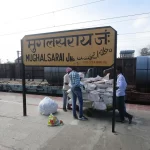
- Explore Katni, Madhya Pradesh: History, Culture, and Nature

- Ludhiana, Punjab, India – The Industrial Heartbeat with Timeless Heritage

- Unveiling Osmanabad (Dharashiv): Maharashtra’s Hidden Gem of History, Caves & Culture
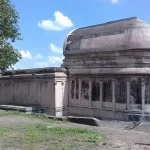
- Explore Sawantwadi: Maharashtra’s Hidden Gem of Heritage, Art, and Natural Splendour

